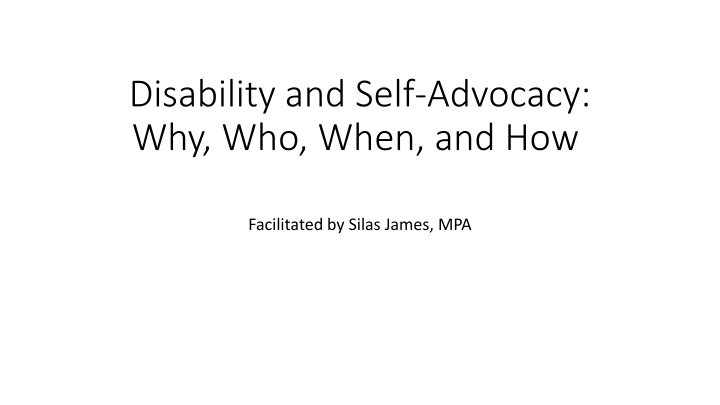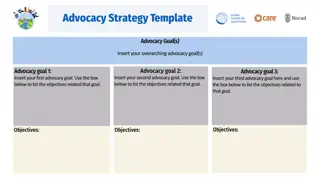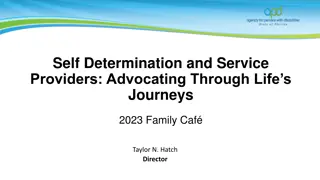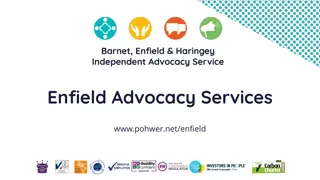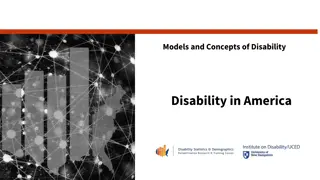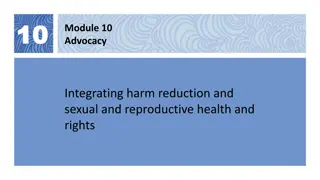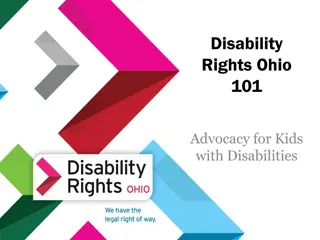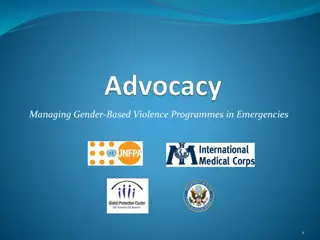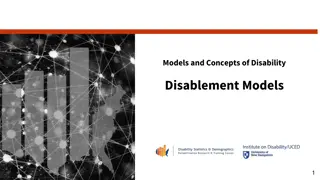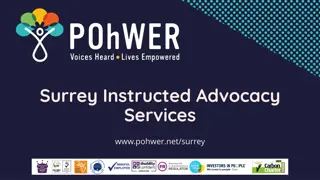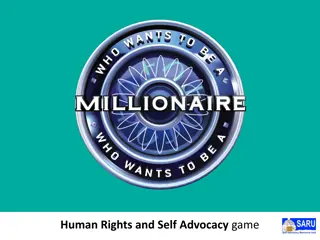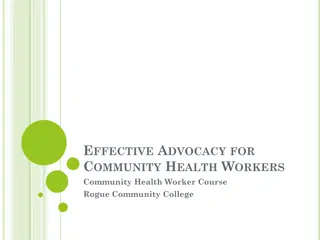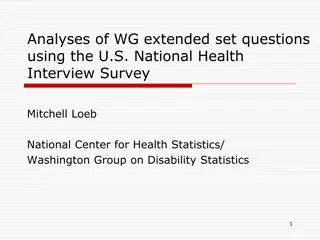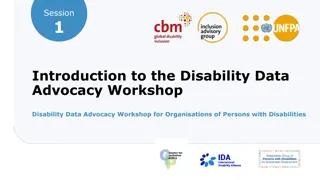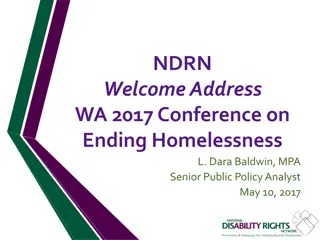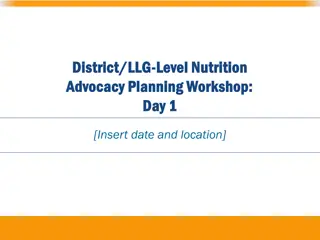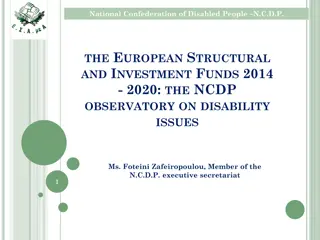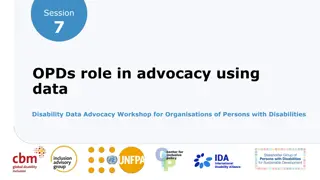Disability and Self-Advocacy: Empowerment Strategies
This informative piece, facilitated by Silas James, MPA, delves into the importance of self-advocacy for individuals with disabilities. It explores the reasons, individuals involved, timing, and methods to advocate effectively for oneself. Readers will gain valuable insights on how to navigate challenges and assert their rights confidently in various settings.
Download Presentation

Please find below an Image/Link to download the presentation.
The content on the website is provided AS IS for your information and personal use only. It may not be sold, licensed, or shared on other websites without obtaining consent from the author.If you encounter any issues during the download, it is possible that the publisher has removed the file from their server.
You are allowed to download the files provided on this website for personal or commercial use, subject to the condition that they are used lawfully. All files are the property of their respective owners.
The content on the website is provided AS IS for your information and personal use only. It may not be sold, licensed, or shared on other websites without obtaining consent from the author.
E N D
Presentation Transcript
Disability and Self-Advocacy: Why, Who, When, and How Facilitated by Silas James, MPA
My perspective and disclaimer My perspective and disclaimer Disability is intersectional. Experiences are shaped by other factors: race, gender, sexual orientation, etc. favoring heterosexual, white, cisgender, able-bodied, males. I am a white cisgender man with a physical disability. That means that if you don t fit into the same socially defined groups as I do, or have different types of disabilities your experience will differ from mine. My experience is related to interactions I ve had about a physical disability.
My perspective and disclaimer My perspective and disclaimer What works for me will be different from what works for you. Please keep this in mind as you think about and engage in your own self advocacy. I do believe that in the ideas I m presenting here are applicable to experiences other than mine. The content of this presentation is based on my personal experience, conversations with others who have disabilities, and my studies of different topics. If anything I discuss here doesn t fit for your situation please adjust it.
What is disability? Who knows? Social Security: Incapable of Substantial Gainful Activity, but you could definitely have a job and be self sufficient and still have a disability. In reality its kind of a moving target defined by society and architecture (why do we have stairs and not ramps?) When does a limp become a thing that puts you into another group? Who knows? Why does a cane make you different but a car increases accessibility more than a cane but nobody considers a car an accessibility device.
Language matters Language represents and shapes our thoughts. The words we use have the ability to change our thinking. I encourage all of you to be thoughtful about why you use the language you use. A Few points: For this presentation try to use Person first language I have or They have vs I am/They are. (There are other perspectives and I can make a strong argument that if you have a disability, that largely shapes your experience.) Personally I don t connect with the term survivor, if you do that s fine but I just encourage you to be aware of why you re saying what you re saying. Disability vs Handicap a handicap is an external barrier or limitation. So using the term handicap to refer to a person is not person first
Introduction exercise: You don t have to introduce your self but if you re comfortable doing so I would love to know more about you. Your name What is a movie, or show that made you laugh recently? OR Something that you ve learned recently? AND Something you hope to get out of this session? I have one request: don t say anything about the cause of your disability, if disability is a part of your identity that s fine but I encourage you not to define yourself relative to an injury.
For many people the social interactions they experience, as For many people the social interactions they experience, as a person considered disabled, are more challenging than the a person considered disabled, are more challenging than the barriers they encounter in society. barriers they encounter in society. In this presentation we ll explore: 1. The groups of people who might engage you on the basis of your abilities. What their motivations might be vs. how it may effect you. 2. What options do you have for responding? 3. How do you learn which situations to respond in which way? How to build on your successes and learn from your failures
Why people treat us like we ARE a disability? They are over empathizing (and projecting) They have a fragile self image (and are threatened) They think that things happen for a reason (things are zero sum)
Microaggressions Microaggressions First used in the 1970s to describe actions or language directed at African Americans, but in the last 20 years the term has come into common use to describe behavior directed at any marginalized group. (Wikipedia) Micro because they re small (hard to identify.) You may not be able to easily talk about what exactly is/was offensive; or if you do you might get pushback. People may not realize what they are doing! (unquestioned assumptions, observed behavior, or mistaken beliefs) MICROASSAULTS *MICROINSULTS *MICROINVALIDATIONS *these are more common in the disability sphere
Microaggressions I saw that youre disabled and I had to say something MICROASSAULTS typical of what you d think of as assaults, but small (Like using the term cripple or other slurs in demeaning ways.) *MICROINSULTS demeaning or degrading comments rooted in a belief that white cisgender heterosexual able-bodied males are supreme. (Usually harder to identify, and even harder to call out, like baby talking someone in a wheelchair, calling them big guy, or someone who walks slowly speedy. ) *MICROINVALIDATIONS these are social, environmental, or interpersonal messages or cues that serve to negate the validity of experiences that deviate from what s considered normal . (unnecessarily holding an automatic door, OR other unsolicited offers of help, or claims that they understand just what you re going through.
Questions or comments about microaggressions?
Who are they? STRANGERS - These are people you won t likely see or interact with again. 2NDdegree friends and retail - People you may see on a somewhat regular basis: Partners of friends, store clerks GATEKEEPERS - These are people who influence your access to things. You may or may not interact with multiple times. PROVIDERS/FAMILY/FRIENDS These are the people who it is worth your time to educate/they influence your outcomes
What can you do? IGNORE You can also say I don t want to talk about it (this seems very small, but it can be a very powerful statement) REDIRECT this is essentially changing the subject. RIDICULE Not the preferable way to respond. EDUCATE this is time intensive but can be rewarding, there are many different ways to approach this.
Strangers Strangers - - IT IS NOT WORTH IT, don t waste your time. Redirect, or Ignore I don t want to talk about it or I m sorry but I don t have time to talk. On language: Be clear about what you want, Ambiguity leaves room for awkward conversations with people who don t understand Please don t do that. Instead of, you don t need to do that this will avoid responses, I don t mind or I want to help . Decline to answer: It s actually a pretty personal question and I don t know you Random strangers offering unsolicited help: you can dismiss them
2 2ND NDDEGREE ACQUAINTANCES/RETAIL DEGREE ACQUAINTANCES/RETAIL Redirect, ignore, or Educate Equally capable of ignorant comments, but the time it takes to educate them can often be worth it. inappropriate or ill-conceived small talk about disability presumptions about needs or limitations (that you don t drive or have cognitive limitations) speaking to the people you re with rather than to you directly (more common in retail) violations of personal space or autonomy (e.g. forced or unsolicited help with groceries)
GATEKEEPERS GATEKEEPERS Their judgements (assumptions) can have actual tangible effects on your outcomes: what providers you are scheduled with, for how long, what your concerns are described as, etc. Advocating with this group of people can be tricky, they may use jargon which mask some of their judgements, they may ask questions about you that are couched in standardized interviews, or they may modify the questions or your answers based on their judgements In some ways it might be better to go through formal channels if you feel you ve been objectified or otherwise demeaned.
PROVIDERS/FAMILY/FRIENDS PROVIDERS/FAMILY/FRIENDS EDUCATING is calling out assumptions (or misunderstandings) for big things it can be confrontational and takes time. Some topics are easy to point out and people are receptive. But other things are harder to hear and people may be defensive. It s also very important to listen to the other persons side, because (especially with caregivers) people are not typically trying to offend you or whatever so also listen and learn. Give and take.
Ignore Just pretend you didn t hear. Will work the best if you can either continue interacting or engage someone else. If there is no one else around you can redirect the person asking or saying the inappropriate thing (for example: beautiful weather today ) typically they ll get the hint. Better than ignoring, in most situations that you d want to ignore someone or something you can say, I don t want to talk about it. It s a final statement that shuts down the conversation, ignoring someone may just lead them to repeat themselves but only louder
Redirect There are multiple ways to do this: You can just blatantly change the subject You can pretend that they said something else Oh thanks these are my favorite shoes! You can direct their question back at them: Are you going to get any better? (this has the potential to be confrontational, and I strongly discourage using this method with people you don t know)
Ridicule Typically avoid. This is rarely a useful tool. Could be dangerous if used in the wrong situation. In some circumstances it could be use to educate or redirect, but there will be a cost. A less confrontational way to respond could be to ask What do you mean? people will often realize how strange they re acting and stumble all over themselves to back track, but they also might not.
Educate The most time intensive thing you can do Also the best outcomes: hopefully substantive change? Use this for people you have important/meaningful interactions with. Could be a range of things: Caregiver: when people ask you what I think about something, I would prefer that you tell them to ask me, instead of answering for me or asking me. Don t touch my wheelchair without my permission I don t think you re hearing me. Can you please repeat what I m saying back to me.
Have an Effective Confrontation Three important factors 1 tell the person exactly how they made you feel. 2 tell the person the specific thing that they did that made you feel that way. 3 tell the person the impact of their action. (Simon Sinek)
How to do it? Choose a simple get out of jail free card for strangers - I don t want to talk about it is great. It might not be exactly right for the situation but still gets the point across. Decide on one group of people (2nddegree or Gatekeepers) to practice on. Maybe there s a type of interaction or specific person that keeps happening or bothers you. Make a plan for what type of response you want to use (redirect is a good one to use when you re practicing, because it can effectively end awkward conversations and there s often no need to follow up with explanation.)
Howd it go? Journaling to promote growth It can be really helpful to keep track of what worked AND what didn t. Remember people aren t all the same, something might work for one person, and another person might not get it (ex: how you getting around today? I DID find everything ok, thank you for asking!) Keeping a journal can help you learn what works and what doesn t
Build the habit of daily journaling Keep track of something that happens every day What you eat/When you go to bed and get up/Exercise, etc Record what you did for the goal of self advocacy. Use the same format, and in the same place in your journal: 1. What/where did it happen? 2. Who? 3. What did you say/do? 4. What was the outcome? 5. What did you learn? Review every week or two: Summary Conclusions
Repeat/Discuss After you have completed a few reviews of weekly (or longer) progress go back and read these reviews, Summarize them and write your conclusions look for themes You can talk about what your learning with someone you trust, a counselor, or in a support group. The act of sharing something you re learning with someone else can help you get a different perspective or better learn to organize your thoughts.
